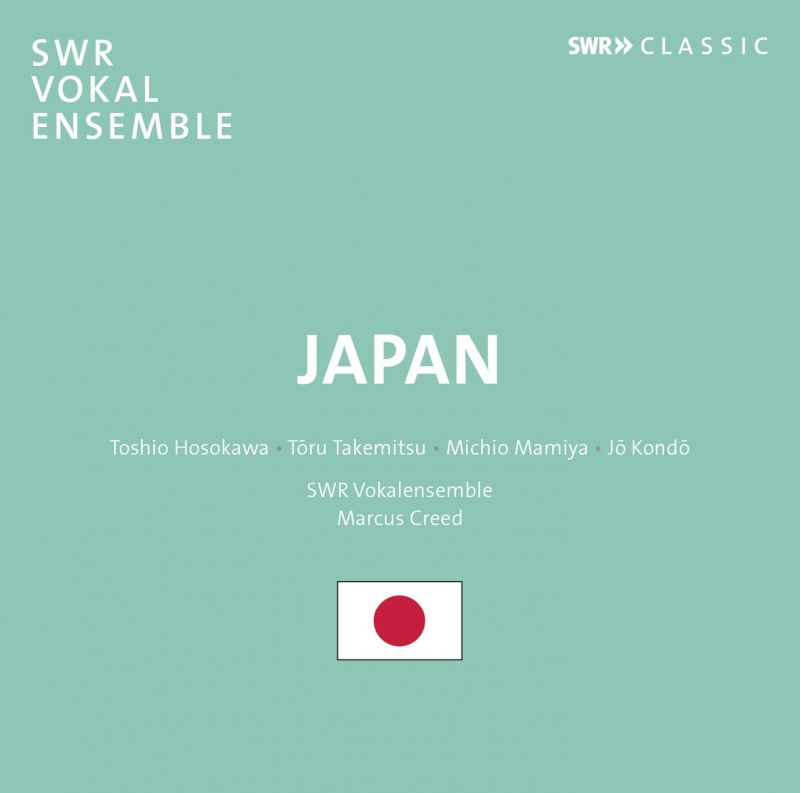Japan: Works for Choir
View record and artist detailsRecord and Artist Details
Composer or Director: Jo Kondo, Toshio Hosokawa, Toru Takemitsu, Michio Mamiya
Genre:
Vocal
Label: SWR Music
Magazine Review Date: 11/2019
Media Format: CD or Download
Media Runtime: 68
Mastering:
DDD
Catalogue Number: SWR19079CD

Tracks:
| Composition | Artist Credit |
|---|---|
| Die Lotusblume |
Toshio Hosokawa, Composer
Marcus Creed, Conductor SWR Vokalensemble Stuttgart Toshio Hosokawa, Composer |
| Wind Horse |
Toru Takemitsu, Composer
Marcus Creed, Conductor SWR Vokalensemble Stuttgart Toru Takemitsu, Composer |
| Composition for Chorus No 1 |
Michio Mamiya, Composer
Marcus Creed, Conductor Michio Mamiya, Composer SWR Vokalensemble Stuttgart |
| Cherry Blossoms (Sakura) |
Toru Takemitsu, Composer
Marcus Creed, Conductor SWR Vokalensemble Stuttgart Toru Takemitsu, Composer |
| Wings, 'Tsubasa' |
Toru Takemitsu, Composer
Marcus Creed, Conductor SWR Vokalensemble Stuttgart Toru Takemitsu, Composer |
| Motet Under the Rose |
Jo Kondo, Composer
Jo Kondo, Composer Marcus Creed, Conductor SWR Vokalensemble Stuttgart |
| Small Sky |
Toru Takemitsu, Composer
SWR Vokalensemble Stuttgart Toru Takemitsu, Composer |
Author: Peter Quantrill
With the gentle tintinnabulations and soft-focus clusters opening Toshio Hosokawa’s Lotus Blossom, for example, we are transported to the pentagonal gardens and Shinto temples of familiar postcards both visual and musical. The abrupt climax is a Noh theatre device, while its placing at the golden-section point owes something to Western forms. In 1967 Pierre Boulez wrote that ‘The musical systems of East and West cannot have any bearing on one another’, but each of the four composers represented here makes his own elegant riposte. The most original and ambitious work is also the most recent: Motet under the Rose by Jo¯ Kondo¯ (b1947), who sets a text by the symbolist poet Kambara Ariake with a great deal more subtlety than the translation he supplies for the booklet: ‘Aus dem tiefstem Grund’ would seem to convey the sense of both the text and of Kondō’s exquisitely pitched clusters, at least more so than ‘At the bottom of the bottoms’.
Takemitsu is an unavoidable presence, represented by a trio of saccharine songs – but then Japanese sweets make a virtue of cloying sweetness and eye-watering colours – and more valuably by the five-movement Wind Horse cycle (1962 66). Each of three vocalises finds its own expressive world within rich, added-seventh harmonies, while the two songs leave Messiaen aside for settings of elliptical stories as tense and understated as a Kurosawa film.
Drawn much more from a local and vernacular tradition is the unpromisingly titled Composition for Chorus No 1 by Michio Mamiya (b1929), a leading member of the ‘Goat’ group of composers who looked towards Bartók as a paradigm of national modernism in which one objective need not compromise the other. There is a bad edit and a false entry at 0'20" in the third of the Composition’s four movements but performances and production otherwise live up to the high standards of the series as a whole.
Discover the world's largest classical music catalogue with Presto Music.

Gramophone Digital Club
- Digital Edition
- Digital Archive
- Reviews Database
- Full website access
From £8.75 / month
Subscribe
Gramophone Full Club
- Print Edition
- Digital Edition
- Digital Archive
- Reviews Database
- Full website access
From £11.00 / month
Subscribe
If you are a library, university or other organisation that would be interested in an institutional subscription to Gramophone please click here for further information.




